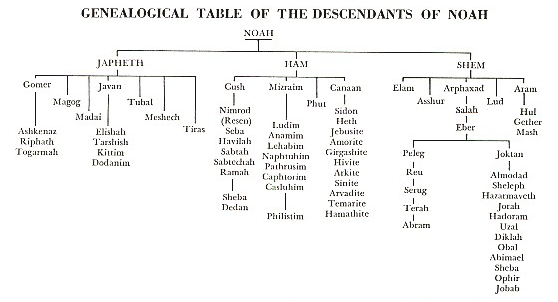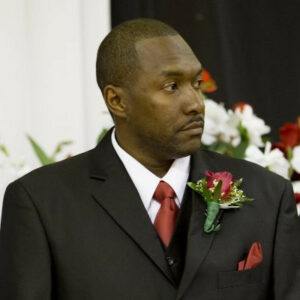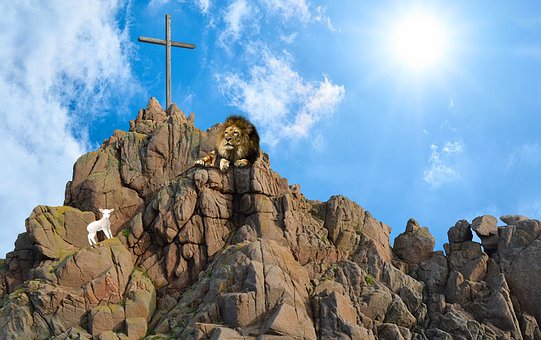God is showing us what He has done with the nations of the world. Why has the white man in our day been so prominent?
Well, I’ll tell you why. Because at the beginning it was the black man, the colored races, that were prominent.
Then the sons of Shem made a tremendous impact upon this world during the time of David and Solomon.
And you will notice that from Shem there came others, such as the Syrians, the Lydians, and the Armenians, also the Arabians from Joktan. These great nations appeared next.
Apparently we are currently in the period in which the white man has come to the front.
It seems that all three are demonstrating that, regardless of whether they are a son of Ham or a son of Shem or a son of Japheth, they are incapable of ruling this world.
God is demonstrating this to us, and to see this is a tremendous thing.
Genesis 10:21-32 KJV
[21] Unto Shem also, the father of all the children of Eber, the brother of Japheth the elder, even to him were children born.
[22] The children of Shem; Elam, and Asshur, and Arphaxad, and Lud, and Aram.
[23] And the children of Aram; Uz, and Hul, and Gether, and Mash.
[24] And Arphaxad begat Salah; and Salah begat Eber.
[25] And unto Eber were born two sons: the name of one was Peleg; for in his days was the earth divided; and his brother’s name was Joktan.
[26] And Joktan begat Almodad, and Sheleph, and Hazarmaveth, and Jerah,
[27] And Hadoram, and Uzal, and Diklah,
[28] And Obal, and Abimael, and Sheba,
[29] And Ophir, and Havilah, and Jobab: all these were the sons of Joktan.
[30] And their dwelling was from Mesha, as thou goest unto Sephar a mount of the east.
[31] These are the sons of Shem, after their families, after their tongues, in their lands, after their nations.
[32] These are the families of the sons of Noah, after their generations, in their nations: and by these were the nations divided in the earth after the flood.

Genesis 10:21
Unto Shem also, the father of all the children of Eber, the brother of Japheth the elder, even to him were children born.
Shem, the older brother of Japheth, or Shem, whose older brother was Japheth, was the father of the Semitic peoples.
The descendants listed represent countries east of Israel, modern Iraq, Iran, and Syria.
The narrator lists these locations within Mesopotamia since Abram, the father of Israel, originated from this area.
Eber receives special attention because of his connection with Abram.
This verse begins the final section of chapter 10’s table of nations, describing how all of the people groups of the ancient world descended from Noah’s three sons.
This section on the line of Shem comes last, though this verse makes clear that Shem was the oldest of Noah’s sons. Earlier, Ham was described using a Hebrew term meaning either “youngest,” or “least” (Genesis 9:24).
Here, translations are split on whether Shem or Japheth is the older brother. Of course, their exact birth order is not explicitly given anywhere in the Bible.
Most likely, but not assuredly, Shem was the oldest of the three sons Noah brought with him on the ark (Genesis 7:1). Shem’s line is the one that will lead to Abraham and the Israelites.
Verse 21 begins by referring to Shem as the father of the Eberites. This is typical of genealogies, especially in the ancient world. The term “father” is often used to refer to any male ancestor (Genesis 15:15; Genesis 31:3).
This makes Shem the “father” of the Eberites, in the sense that, as Eber’s great grandfather, Shem is the ancestor of that people. Through the Eberites, eventually, Shem’s line will lead to Abraham (Abram).
Genesis 10:22
The children of Shem; Elam, and Asshur, and Arphaxad, and Lud, and Aram.
The descendants of Elam lived in the region of modern southwestern Iran. The descendants of Asshur were later Assyrians who lived under Nimrod’s jurisdiction. Sumerians descended from Ham were ousted by Mesopotamian Semites.
Arphaxad possibly settled northeast of Nineveh; his descendants are further described in Gen 11:12-26. Lud was near the Tigris River; its people were related to the Lydians. Aram was a kingdom of tribes that lived in the Mesopotamian plains.
This verse lists the sons of Noah’s son Shem. Shem’s descendants Elam and Asshur will found significant people groups, well known historically and deeply involved in the history of Israel.
Less is known about the peoples that came from Lud and Aram. Much of this same genealogical material is presented in the book of 1 Chronicles (1 Chronicles 1:17–25).
Shem’s line through his son Arpachshad is the one that leads to Abraham (Abram) and Israel. This makes Shem the ancestor of figures such as King David and Jesus Christ.

Genesis 10:23
And the children of Aram; Uz, and Hul, and Gether, and Mash.
The patriarchs later interacted with the descendants of Aram. Uz was the chief Aramean tribe, possibly located northeast of the Jordan; it was Job’s home. Hul is unknown. He possibly founded Armenia.
Gether is unknown; he was possibly the founder of the Syrians. Mash might be associated with Mount Masus in northern Mesopotamia or with a part of the Lebanon Mountains.
The purpose of this passage of Scripture is to explain the origins of the ancient world’s various nations and people groups. Some, such as the descendants of Ham’s son Canaan, would become highly influential in the history of Israel.
For that reason, the Bible devotes more details to them. Others, such as the men listed here, do not seem to have had a significant impact on the ancient world.
This verse lists the sons of Shem’s son Aram. Little is known from the Bible or external records about the groups that came from these men.
The only noteworthy name given here is that of Uz, which is the same as the native land of Job (Job 1:1), mentioned in a few places in Scripture (Jeremiah 25:20; Lamentations 4:21).

Genesis 10:24
And Arphaxad begat Salah; and Salah begat Eber.
Arphaxad was the father of Shelah: Greek version reads Arphaxad was the father of Cainan, Cainan was the father of Shelah.
Shelah is unknown, but may be short for Methushelah.
Eber was the ancestor of Abram the Hebrew.
This verse continues the genealogy of Noah’s son Shem. Chapter 10 traces the origins of the ancient world’s various people groups—all of whom come from the three sons of Noah: Shem, Ham, and Japheth.
Some of these early descendants founded great and powerful people groups.
Ham’s son, Mizraim, is also known as Egypt. Ham’s son Canaan will father several cultures which become bitter enemies of Israel.
This chapter shows the origins of city-states and nations which become well-known throughout the rest of the Old Testament, such as Magog, Tarshish, Kittim, Cush, Babel, Nineveh, Sidon, and so forth.
Shem’s line leads through Arpachshad to Shelah to Eber and eventually to Abraham and the Israelites. This makes Shem the ancestor of the Messiah, Jesus Christ.
It also fulfills the curse given by Noah (Genesis 9:20–25) that Canaan’s descendants would be subservient to those of Shem.

Genesis 10:25
And unto Eber were born two sons: the name of one was Peleg; for in his days was the earth divided; and his brother’s name was Joktan.
Peleg means division, anticipating the separation of people into language groups after Babel. Peleg’s line led to Abram.
Joktan was the ancestor of the southern Arabian tribes. The Ishmaelite tribes were in northern Arabia.
When I went over this verse in a previous Bible study, I received all sorts of weird interpretations of what was meant by “the earth was divided”—that it refers to a physical division here in the earth, that the earth had undergone some tremendous physical catastrophe.
Well, my friend, all that Moses is simply doing is anticipating the next chapter in which he will give us the account of the Tower of Babel. At that time the earth was divided.
May I say that the simple interpretation seems to be the one that a great many folk miss, and we should not miss it.
This verse continues the genealogy of Noah’s son Shem. Shem’s great grandson Eber fathered two sons. Shem’s line will continue through Peleg to Abraham and the Israelites.
This passage also makes an interesting comment about one of Shem’s descendants, Peleg. Peleg’s name apparently comes from an ancient word meaning “to divide.”
The division of the earth in Peleg’s mentioned here likely refers to the division and dispersal of humanity that will happen after the events surrounding the tower of Babel.
At that point, mankind will be dispersed over the earth, and their languages confused. Those events are described in chapter 11.
This side-long reference to Peleg is also useful for understanding ancient writing. This part of Genesis describes the descendants of Noah’s sons, including their eventual geography. But chapter 11 will describe a moment when mankind is dispersed over the earth.
This is due to the fact that Genesis, like many ancient records, is more concerned with themes than with chronology. In other words, the story of the Tower of Babel is not the point of this particular text, so it will be mentioned later.
Scholars suggest that Eber’s other son Joktan will become the father of Arab peoples.

Genesis 10:26
And Joktan begat Almodad, and Sheleph, and Hazarmaveth, and Jerah,
There were fourteen sons of Shem by Eber through Joktan. The placement of the Babel story between the lines of Joktan and Peleg ties Joktan to the judgment of the Babel story and ties Peleg to Abram.
This verse continues the genealogy of Shem, listing the sons of his great-great-grandson, Joktan. In total, 13 sons are listed. The names of several of these sons became associated with well-known areas in the larger region of the Middle East.
This is part of chapter 10’s “table of nations,” explaining the origin of the ancient world’s various people groups. The actual dispersal of these people to their eventual geographic regions, does not seem to occur until chapter 11 at the incident of the Tower of Babel.
Jerah is a Hebrew word meaning “new moon.” Later on in history, the moon would become one of the foremost gods worshiped in the region, which seems to be the ancestral homeland of Arabic peoples.
Genesis 10:27
And Hadoram, and Uzal, and Diklah,
Hadoram was an Arabian tribe. Uzal was Sana’a, an old capital of Yemen in pre-Islamic times. Diklah was a southern Arabian oasis in Mina.
This verse continues the “table of nations,” describing the origins of the ancient nations. All of these tribes and people were descended from Noah, through his sons Shem, Ham, and Japheth.
Earlier passages gave details about the children of Japheth, and then Ham. Here, verse 27 continues the genealogy of Shem, through his great-great-grandson Joktan.
In total, 13 sons are listed. The names of several of these sons became well known areas in the larger region of the Middle East.
The name Uzal may be Azal, an old name for Sann’a, the modern-day capital of Yemen, indicating that this branch of Joktan’s line settled in that area.
Genesis 10:28
And Obal, and Abimael, and Sheba,
Obal was between Hodeida and Sana’a in southwest Arabia. Abimael was a Sabaean. Sheba was in southern Arabia.
This verse continues listing the sons of Joktan, the great-great-grandson of Shem. In total, 13 sons are listed. The names of several of these sons became well known areas in the larger region of the Middle East.
As such, Joktan would be considered the father of the Arabic people.
This particular part of Genesis is only concerned with explaining the family relationships involved. Exactly how and when these descendants arrived in their territories is not explained here.
Later, chapter 11 will explain the incident of the Tower of Babel, where these various people and tribes are dispersed across the earth.

Genesis 10:29
And Ophir, and Havilah, and Jobab: all these were the sons of Joktan.
Ophir was a region of southern Arabia between Sheba and Havilah; it was a source of gold. Havilah was in southwest Arabia. Jobab was possibly Jobebitai in southern Arabia.
Joktan was a great-great-grandson of Shem, one of Noah’s three sons. In this chapter, sometimes called the “table of nations,” Scripture explains the origins of the various kingdoms and people groups of the ancient Middle East.
Joktan is credited here with 13 sons; several of these names will become well-known within the regions surrounding Israel.
In fact, Joktan seems to be the father of the Arabic people, as his sons are the primary inhabitants of those lands. The regions of Ophir and Havilah were famous in the ancient world for their gold (Genesis 2:11).
Genesis 10:30
And their dwelling was from Mesha, as thou goest unto Sephar a mount of the east.
Mesha was a region in northern Arabia, south of Hadramaut.
Sephar is identified with Isfar, south of Hadramaut in Yemen.
The previous few verses listed the 13 sons of Joktan, the son of Eber. The names of several of these sons became well known as specific regions or people groups in the Middle East.
This verse describes the geographical territory occupied by the various groups of people descended from Joktan. Scholars are uncertain of exactly what modern day areas these names represent.
However, the information given in the broader passage indicates that Joktan was the father of the Arabic people.
This portion of Scripture is devoted to explaining how Shem, Ham, and Japheth, Noah’s sons, became the ancestors of all of the world’s nations.
Some of the names listed here will become associated with famous—or infamous—cities or regions of the Bible. An explanation for how they found themselves living in different locations and speaking different languages, will come in chapter 11.
Those details are part of the story of the Tower of Babel (Genesis 11:1–9).
Genesis 10:31
These are the sons of Shem, after their families, after their tongues, in their lands, after their nations.
These, then, were the descendants of Shem, classified according to their political groupings, languages, and geographical locations.
This verse serves to formally conclude the genealogy of Shem and his descendants, along with describing the regions in which they settled. However, the line from Shem to Abraham will be described more specifically in chapter 11.
This entire chapter has been devoted to explaining the origins of the Middle East’s various nations. All people, including every possible tribe or race, are descended from Noah and his sons Shem, Ham, and Japheth.
Notably, the details in this part of the Bible are only concerned with family relationships.
Other than a quick comment about Peleg (Genesis 10:25), the story of how the different tribes wound up with separated languages and territories is left entirely to the next part of Scripture.
That explanation will come through the story of the Tower of Babel.

Genesis 10:32
These are the families of the sons of Noah, after their generations, in their nations: and by these were the nations divided in the earth after the flood.
Although not every ancient people group is listed in this “Table of the Nations,” its clear teaching is that all the varied peoples of the earth, no matter of what land or language, are descended from Noah.
I want to submit to you that this is one of the great chapters of the Bible although we have given very little space to it. You can see what a rich study this would make for anyone who really wanted a fair appraisal of the human family.
A great many have used this remarkable chapter for that purpose.
This verse serves as a formal conclusion to chapter 10’s table of nations.
It has finished its work of presenting the genealogy of Noah through his three sons and their sons and describing the peoples and nations that came from them, along with the regions in which they settled following the Tower of Babel.
Rather than focusing on a single, deep line of fathers and sons, this list has emphasized the broad connection between all people.
Instead of delving into the details of how they came to be separate people, with separate nations and languages, this passage simply explains how these men were related to each other.
The story of the Tower of Babel and the dispersal of humanity will be told in chapter 11, starting in the very next verse.
I hope that you have really enjoyed this post,
Please Leave All Comments in the Comment Box Below ↓













This thought-provoking blog post brilliantly delves into the rich tapestry of human history, showcasing the interconnectedness and remarkable diversity of the Sons of Shem, Syrians, Lydians, Armenians, and Arabians.
It’s truly awe-inspiring to witness how these ancient civilizations have shaped our collective heritage, leaving behind a legacy that continues to shape our world today. The meticulous research and captivating storytelling in this article have opened my eyes to the intricate threads that bind us all, reminding us of the power and beauty found in embracing our shared human experiences.
Bravo to you for shedding light on these lesser-known connections and fostering a deeper appreciation for our global tapestry of cultures and civilizations.
Hello Dave,
Thank you for chosing to stop by the HBS & DwJ website to share your comments with us.
I am really pleased to learn that information this article have opened your eyes to the intricate threads that bind us all. You are most certainly welcome for the light shedding.
Thank you so much for your adoration about the sharing of this information.
Blessings My Friend!
I recently had the pleasure of reading the article on “Sons of Shem: Syrians, Lydians, Armenians, Arabians” from “God in Our Lives Every Day,” and it provided a captivating journey into the history and significance of these ancient civilizations.
The author’s deep knowledge and passion for biblical studies shine through, making this article an enlightening read. By shedding light on the connections between these diverse cultures, the article offers valuable insights into their contributions to human history and the profound impact they had on shaping the world we live in today.
Highly recommended for those seeking a deeper understanding of the rich tapestry of our shared human heritage.
Hello Steve,
Thank you for taking the opportunity to comment on Sons Of Shem – Syrians, Lydians, Armenians, Arabians, and considering that it provided a captivating journey into the history and significance of these ancient civilizations.
If you tune into the HBS & DwJ Podcast, you will hear me shout you out by reading your comment.
Blessings To You My Friend!
Wow, this is such an interesting perspective on the origins of different nations and peoples!
It’s fascinating to see how the descendants of Shem, like the Syrians, Lydians, Armenians, and Arabians, played a significant role in shaping the ancient world.
The mention of the white man being prominent in our day raises some thought-provoking questions. It seems that throughout history, different races and ethnicities have taken turns in prominence, showcasing that no single group is capable of ruling the world effectively.
It’s remarkable how God is using these shifts in power to demonstrate a greater truth to us. This chapter truly provides a rich study on the human family and our shared ancestry.
Thanks for sharing this enlightening piece of biblical history!
Hello Olatunji,
Thank you for continuing to stop by, read, and take time to comment on yet another Holy Bible Study session, turned HBS & DwJ Podcast episode.
I also want to thank you for considering this such an interesting perspective on the origins of different nations and peoples.
Thank you for your continued support with helping HBS & DwJ spread GOD’s Word.
You are most certainly welcome for the sharing of this enlightening piece of biblical history. Thank you for considering it in this manner.
Continued Blessings Unto You My Friend!
Impressive! It is such an exciting perspective on the origins of different nations and peoples!
It’s fascinating to see how the descendants of Shem, like the Syrians, Lydians, Armenians, and Arabians, played a significant role in shaping the ancient world.
The mention of the prominent white man in our day raises some thought-provoking questions. Throughout history, different races and ethnicities have become apparent, showcasing that no single group can rule the world effectively.
It’s remarkable how God is using these shifts in power to demonstrate a greater truth to us.
This chapter thoroughly studies the human family and our shared ancestry.
Thanks for sharing this enlightening piece of biblical history!
Elke
Hello Elke,
Thank you for your comment on this HBS & DwJ Podcast episode.
Your comments are greatly appreciated, Thank you for your appreciation of this topic.
Please come back and visit this website, the podcast, and the store anytime.
Blessings My Friend!
The article beautifully navigates through the intricate genealogy and historical lineage of nations, tracing back to the descendants of Shem, one of Noah’s sons.
The meticulous presentation of various groups like Elam, Asshur, Arphaxad, Lud, Aram, and others showcases the author’s commendable research and storytelling skills. The narrative’s ability to connect these historical threads to the Tower of Babel incident and the subsequent dispersion into distinct language groups is truly impressive.
This insightful exploration of the origins of nations and their interwoven fates serves as a testament to the author’s adeptness in blending genealogy, geography, and linguistic evolution. The article offers an engaging journey into the depths of human history, emphasizing the multifaceted nature of our interconnected world.
Kudos to the author for skillfully weaving together history, culture, and language into an enlightening tapestry of knowledge!
Hello Ashley,
Welcome back to the HBS & DwJ Platform.
I am glad to learn that you find this information to be one that beautifully navigates through the intricate genealogy and historical lineage of nations, with a meticulous presentation of various groups.
Oh believe me, I really do work extremely hard on making sure I am sharing all of the information I can for those who are trying to study the Holy Bible in depth.
Thank you for your participation.
Blessings My Friend!
An excellent read that will keep readers – particularly me – coming back for more!
Thank you and best of luck!
Hello Felix,
Thanks for continuing to stop by and comment on these articles, turned podcast episodes.
Blessings My Friend!!!